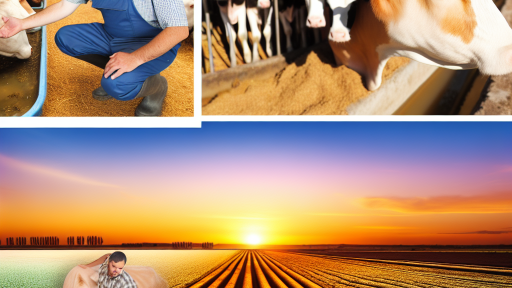Understanding Organic Farming Principles for Small-Scale Agriculture
Foundation of Organic Practices
Organic farming relies on natural processes to enhance productivity.
This approach prioritizes soil health and biodiversity.
Farmers use crop rotation, cover crops, and composting techniques.
By avoiding synthetic fertilizers, they maintain ecosystem balance.
Additionally, integrated pest management minimizes harmful interventions.
Importance of Soil Health
Healthy soil forms the basis of successful organic farming.
It stores nutrients, retains water, and supports plant growth.
Organic matter, such as compost, enriches soil structure.
Furthermore, earthworms and microorganisms promote nutrient cycling.
These practices lead to better crop yields and resilience.
Encouraging Biodiversity
Biodiversity plays a critical role in organic agriculture.
By planting diverse crops, farmers reduce pest outbreaks.
This diversity also improves soil health and pollination rates.
Farmers often integrate livestock to enhance nutrient recycling.
Companion planting fosters beneficial relationships among plants.
Transform Your Agribusiness
Unlock your farm's potential with expert advice tailored to your needs. Get actionable steps that drive real results.
Get StartedStrategies for Pest Management
Effective pest management is essential for organic success.
Farmers can use natural predators to control pest populations.
Planting pest-repellent varieties also provides protection.
Regular monitoring allows for early identification of issues.
Moreover, creating habitats for beneficial insects supports balance.
Economic Benefits of Organic Methods
Small-scale organic farming can yield financial advantages.
Organic products often fetch higher market prices.
Farmers cultivate niche markets, attracting local consumers.
Additionally, reduced chemical costs lower overall expenses.
Farmers enjoy improved long-term sustainability and profitability.
Community and Consumer Engagement
Engaging with local communities enhances organic farming’s impact.
Farmers can join cooperatives to share resources and knowledge.
Community-supported agriculture (CSA) fosters direct consumer relationships.
Moreover, education initiatives inform consumers about organic benefits.
This engagement builds trust and drives demand for organic products.
Soil Health Techniques to Improve Soil Fertility Naturally
Understanding Soil Composition
Soil is composed of minerals, organic matter, water, and air.
These components interplay to influence fertility and plant health.
Maintaining a balanced soil composition is essential for organic farming.
Enhancing Organic Matter
Adding organic matter improves soil structure and nutrient availability.
You can use compost, manure, or cover crops as sources of organic matter.
These methods help maintain soil moisture and reduce erosion.
Moreover, organic matter fosters beneficial microbial activity in the soil.
Utilizing Cover Crops
Cover crops prevent soil erosion during off-seasons.
They enhance soil fertility through nitrogen fixation and organic matter addition.
Showcase Your Farming Business
Publish your professional farming services profile on our blog for a one-time fee of $200 and reach a dedicated audience of farmers and agribusiness owners.
Publish Your ProfileCommon options include clover, vetch, and rye.
Additionally, they suppress weeds and promote biodiversity.
Practicing Crop Rotation
Crop rotation diversifies soil nutrients and reduces pest buildup.
Every crop type influences soil health differently.
Plan rotations based on crop families and nutrient needs.
This practice helps maintain balanced soil fertility over time.
Implementing No-Till Farming
No-till farming minimizes soil disruption and erosion.
This approach helps retain moisture and improves soil structure.
Furthermore, it promotes the survival of beneficial insects and microorganisms.
Adopting this method can lead to healthier, more productive soils.
Testing Soil Regularly
Regular soil testing provides vital information about nutrient levels.
This practice helps you understand your soil’s specific needs.
Adjustments can then be made based on testing results.
Timely interventions can enhance overall soil health significantly.
Incorporating Mulching Techniques
Mulching helps retain soil moisture and suppress weeds.
Organic mulches like straw, grass clippings, and leaves work best.
These materials decompose, further enriching the soil.
Additionally, mulching can improve your garden’s aesthetic appeal.
Encouraging Biodiversity in Soil
Promoting biodiversity encourages a healthy soil ecosystem.
Consider planting a variety of plants to attract beneficial insects.
Diverse plantings help reduce disease risk and nutrient depletion.
This method supports a more resilient soil environment.
Crop Selection: Choosing High-Yielding Organic Varieties for Small Spaces
Understanding Organic Varieties
Organic varieties are bred to thrive without synthetic fertilizers or pesticides.
They often require different care compared to traditional varieties.
It’s crucial to research local organic varieties suited for small spaces.
Identifying High-Yielding Options
Look for plants specifically labeled as high-yielding.
Varieties with compact growth habits can maximize space efficiently.
Consult local nurseries for recommendations on successful species.
Factors to Consider in Crop Selection
Climate adaptability plays a significant role in yield potential.
Choose varieties that correspond with your region’s growing conditions.
Consider the growth cycle of plants to ensure timely harvests.
Creating a Diverse Planting Plan
Diversity helps prevent pest problems and enhances soil health.
Mixing crops can improve pollination and nutrient availability.
Incorporate companion planting strategies for optimal results.
Resources for Finding Varieties
- Online seed catalogs provide extensive information on organic varieties.
- Gardening forums can offer insights from other successful growers.
- Local agricultural extension services often have valuable resources.
Experimenting with Heritage and Heirloom Seeds
Heirloom seeds can produce unique and flavorful crops.
These varieties often adapt well to local conditions over time.
Experimentation with different heirlooms can lead to surprising yields.
Delve into the Subject: Sustainable Irrigation Techniques For Modern Farms
Pest Management: Utilizing Natural Predators and Organic Pest Control Methods
Understanding the Role of Natural Predators
Natural predators play a crucial role in maintaining pest populations.
They effectively reduce reliance on chemical pesticides.
Showcase Your Farming Business
Publish your professional farming services profile on our blog for a one-time fee of $200 and reach a dedicated audience of farmers and agribusiness owners.
Publish Your ProfileFor instance, ladybugs consume aphids, minimizing damage to crops.
Moreover, introducing beneficial insects can enhance biodiversity.
Farmers can create habitats that attract these helpful species.
Implementing Organic Pest Control Techniques
Organic pest control methods promote environmentally friendly practices.
These techniques often include using insecticidal soaps and neem oil.
Additionally, crop rotation helps disrupt pest life cycles.
Companion planting can deter pests and enhance plant health.
Garlic spray is another effective natural remedy against pests.
Monitoring Pest Activity
Regular monitoring allows farmers to identify pest issues early.
Using traps can help track pest populations effectively.
Farmers should inspect crops weekly to assess damage.
Identifying specific pests enables targeted control methods.
Creating a Diverse Ecosystem
A diverse ecosystem strengthens natural pest control.
Planting a variety of crops can confuse pests and reduce infestations.
Native plants attract beneficial insects, enhancing predator presence.
Furthermore, maintaining healthy soil cultivates resilient crops.
Educating and Involving the Community
Education is vital for successful pest management strategies.
Workshops can empower local farmers with knowledge on techniques.
Community involvement fosters a shared commitment to organic practices.
As a result, collective efforts can significantly reduce pest populations.
You Might Also Like: Connecting Farms with Schools: A Farmer’s Guide
Water Management: Efficient Irrigation Techniques for Small-Scale Farms
Importance of Water Management
Water management is vital for maximizing yields.
Efficient irrigation conserves resources and reduces costs.
Proper techniques lead to healthier crops and better harvests.
Types of Irrigation Techniques
Various irrigation techniques suit small-scale farming.
Drip irrigation minimizes water loss and targets roots.
It delivers water directly where plants need it most.
Sprinkler systems are versatile and cover larger areas.
These systems can be adjusted for varying crop needs.
Implementing Rainwater Harvesting
Rainwater harvesting is an effective way to supplement irrigation.
It collects and stores rainwater for later use.
This technique reduces dependence on traditional water sources.
Farmers can use inexpensive materials for storage systems.
- Use barrels or tanks to capture rainwater.
- Install gutters to channel water from rooftops.
- Ensure proper filtration to keep water clean.
Soil Moisture Management
Monitoring soil moisture is essential for effective irrigation.
Use moisture sensors to determine when to irrigate.
These tools can help avoid overwatering or underwatering.
Additionally, maintaining organic matter improves soil retention.
Applying mulch reduces evaporation and keeps soil moist.
Strategies for Efficient Water Use
Implementing water-saving practices is crucial for sustainability.
Schedule irrigation during cooler periods to minimize evaporation.
Showcase Your Farming Business
Publish your professional farming services profile on our blog for a one-time fee of $200 and reach a dedicated audience of farmers and agribusiness owners.
Publish Your ProfileUse native plants that require less water and maintenance.
Consider crop rotation to enhance soil and water health.
- Choose drought-resistant varieties for your crops.
- Integrate cover crops to improve soil structure.
- Adopt conservation tillage practices to maintain moisture.
Regular Maintenance and Evaluation
Regular maintenance of irrigation systems prevents issues.
Inspect for leaks and ensure equipment functions properly.
Evaluate water use and crop yields to identify improvements.
Adjustment based on evaluation helps optimize productivity.
Stay informed about new technologies and methods in irrigation.
Learn More: Local Food Sourcing Tools and Resources for Farmers

Companion Planting: Strategies for Maximizing Space and Yield
Understanding Companion Planting
Companion planting involves pairing plants to enhance growth and productivity.
This method increases yields and utilizes space efficiently.
Plants can benefit each other through pest control and mutual support.
Moreover, certain combinations promote better nutrient uptake in the soil.
Benefits of Companion Planting
Companion planting offers numerous advantages for small-scale gardeners.
Firstly, it reduces the need for chemical pesticides.
Secondly, it can improve flavor and growth in certain crops.
Additionally, companion plants can attract beneficial insects.
Ultimately, this method increases overall biodiversity in the garden.
Common Companion Planting Combinations
Many plants pair well together to promote growth.
For instance, tomatoes and basil thrive side-by-side.
They not only enhance each other’s flavors but also reduce pests.
Similarly, carrots and onions deter root pests when planted together.
Moreover, beans can fix nitrogen in the soil, benefiting nearby plants.
Implementing Companion Planting in Your Garden
Start by researching potential companion plants for your crops.
Mapping your garden layout can simplify the process.
Next, prepare the soil properly to ensure success.
After planting, monitor the growth and interactions between plants.
Finally, adjust combinations based on observed outcomes.
Challenges and Considerations
While companion planting is beneficial, challenges may arise.
For example, some plants may compete for resources.
Additionally, not all combinations yield positive results.
Therefore, trial and error can be essential in finding ideal pairings.
Remember to focus on specific plants best suited for your environment.
Learn More: Local Food Sourcing Strategies for Small Farms
Crop Rotation: Benefits and Techniques for Sustainable Yield Improvement
Understanding Crop Rotation
Crop rotation is a farming practice that enhances soil health.
It involves alternating different crops on the same land over time.
This method disrupts pest and disease cycles, improving crop resilience.
Benefits of Crop Rotation
Implementing crop rotation can significantly boost yields.
It helps prevent soil degradation and nutrient depletion.
Additionally, it promotes biodiversity within the farm ecosystem.
Crop rotation also aids in controlling weeds naturally.
Showcase Your Farming Business
Publish your professional farming services profile on our blog for a one-time fee of $200 and reach a dedicated audience of farmers and agribusiness owners.
Publish Your ProfileCommon Rotation Techniques
Many farmers adopt specific techniques to maximize advantages.
One method is the three-year rotation cycle.
This often includes legumes, grains, and root vegetables.
Such a cycle allows nutrients to replenish naturally.
Choosing the Right Crops
Selecting suitable crops is critical for effective rotation.
Consider planting legumes after nitrogen-depleting crops.
Legumes enrich the soil with essential nitrogen.
Also, rotate deep-rooted plants with shallow-rooted ones.
Implementation Strategies
Successful implementation entails careful planning and observation.
Start by mapping out areas for each crop type.
Monitor soil conditions and crop health continually.
This approach enables timely adjustments to the plan.
Challenges of Crop Rotation
While beneficial, crop rotation can present challenges.
Weather patterns may affect the success of certain crops.
Allocating space for different crops can also be complex.
However, overcoming these challenges leads to healthier soils.
Long-Term Impact on Yield
In the long run, crop rotation enhances overall productivity.
Healthy soil results in robust crops and better yields.
Ultimately, it contributes to sustainable farming practices.
Market Access: Strategies to Sell Organic Produce and Maximize Profitability
Building Strong Relationships
Establishing relationships with local retailers is crucial.
Farmers should approach shops that prioritize organic products.
This fosters trust and encourages mutually beneficial deals.
Additionally, attending farmers’ markets enhances visibility.
Direct-selling allows farmers to connect with their customers.
Leveraging Online Platforms
In today’s digital world, online sales are essential.
Farmers can create dedicated websites or use e-commerce platforms.
These avenues allow reaching broader audiences effectively.
Utilizing social media can increase brand awareness.
Engaging content attracts potential customers and drives sales.
Implementing Subscription Models
Subscription services can generate steady revenue streams.
Offering boxes of fresh produce each week appeals to consumers.
This model provides convenience and fosters customer loyalty.
Additionally, farmers can promote seasonal offerings this way.
Customized boxes can cater to specific dietary needs.
Participating in Community Supported Agriculture (CSA)
Community Supported Agriculture promotes local produce.
Consumers can invest upfront for a season’s worth of goods.
This strengthens community ties and secures sales in advance.
Farmers can leverage social media to encourage participation.
Highlighting the benefits of supporting local agriculture attracts members.
Utilizing Certification and Branding
Organic certification adds value to produce offerings.
Showcase Your Farming Business
Publish your professional farming services profile on our blog for a one-time fee of $200 and reach a dedicated audience of farmers and agribusiness owners.
Publish Your ProfileIt reassures consumers about product quality and integrity.
Branding plays a crucial role in differentiating products.
Developing memorable packaging enhances recognition.
Storytelling in marketing can connect deeply with consumers.
Diversifying Product Range
Offering a variety of products can appeal to more customers.
Farmers can explore value-added products like jams or sauces.
Diversification mitigates risks associated with crop failures.
This strategy enables farmers to attract different customer segments.
Seasonal offerings can create excitement and drive sales year-round.
Additional Resources
What is Syntropic Farming?: A Permaculture Perspective — Porvenir …




